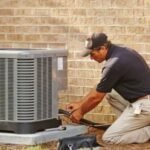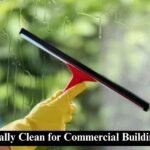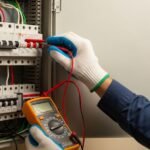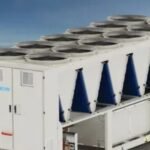Your AC unit might not be cooling as well as it should. Dirty units use more energy and cool less effectively. This guide will show you how to clean your AC for better performance.
Keep reading for simple secrets.
Pre-Cleaning Preparation
Before starting the cleaning, gather the tools and safety gear you’ll need. Don’t forget to turn off the power to the AC unit before opening it up for maintenance.
Gather necessary tools and safety gear
To clean your AC unit, you need the right tools and safety equipment. Grab a screwdriver, garden hose, fin comb, coil cleaner, gloves, and protective glasses. These items help you do the job safely and effectively.
Gloves protect your hands from sharp metal edges. Protective glasses keep dust and debris out of your eyes.
The next step is to make sure the power to the AC unit is off before starting any work. This precaution keeps you safe while handling the parts inside.
Turn off the power to the AC unit
After you have all your tools and safety gear ready, the next step is turning off the power to the AC unit. This step is crucial for your safety. You can turn off the power at the main switch or circuit breaker box in your home.
This stops electricity from reaching the unit while you are working on it. Shutting down the power ensures that you can safely clean parts like coils and filters without risking an electric shock. Whether you’re performing routine maintenance or cleaning your AC unit after months of heavy use, this step is non-negotiable. Always double-check to make sure that all electrical connections to your AC system are completely off before starting any cleaning task.
Step-by-Step Cleaning Guide
Gather the necessary tools and safety gear for cleaning. Turn off the power to the AC unit before starting.
Cleaning the air filters
Cleaning air filters is a key step in maintaining your AC unit’s efficiency and ensuring clean indoor air quality. Dirty filters can block airflow and reduce the system’s performance.
- Turn off your AC system before you start.
- Locate the air filter panel on your indoor unit. This is usually found on the front or top of the unit.
- Open the panel and slide out the air filter.
- Check the condition of the filter to decide if you need to clean or replace it.
- If you are cleaning, gently remove dust using a soft brush or a vacuum cleaner equipped with a brush attachment.
- For deeper cleaning, wash the filter with mild soap and warm water.
- Rinse thoroughly and let the filter dry completely before putting it back.
- If the filter is too worn or damaged, buy a new one that fits your model.
- Slide the clean or new filter back into place securely.
- Close the air filter panel properly.
- Turn on your AC system and check for improved airflow.
Regularly cleaning or replacing your air filters boosts energy efficiency and helps keep indoor air clean.
Clearing and washing the outdoor unit
After ensuring the air filters are clean, it’s equally important to clean and rinse the outdoor unit. This step helps maintain the efficiency of the AC system and ensures proper airflow.
- Remove any debris: Inspect the area around the outdoor unit and eliminate any leaves, branches, or other clutter that may have built up. This will prevent airflow blockage and potential damage to the unit.
- Clearing the fins: Carefully vacuum or brush the aluminum fins on the exterior of the unit to eliminate any dirt or debris buildup. Keeping these fins clear helps with airflow and overall efficiency.
- Rinsing the unit: Gently spray down the exterior of the outdoor unit with a garden hose to eliminate dirt, dust, and other buildup. This helps maintain proper heat exchange and keeps the unit running efficiently.
- Trimming vegetation: Ensure that there is at least two feet of clearance around the entire outdoor unit by trimming back any nearby shrubs or plants. This allows for proper airflow and ventilation.
- Checking for levelness: Verify that the outdoor unit is sitting level on its pad or base to prevent strain on internal components and ensure proper drainage.
- Inspecting for damage: Take a close look at the exterior of the unit for any signs of physical damage or corrosion, addressing any issues promptly to prevent further damage.
- Securing panels: Double-check that all panels on the outdoor unit are securely in place to prevent foreign objects from entering and causing damage to internal components.
By following these steps regularly, you can help your AC system function more efficiently and prolong its lifespan while saving energy in your home.
Cleaning the indoor coils and fins
After clearing and washing the outdoor unit, it’s crucial to proceed with cleaning the indoor coils and fins.
- Power Off: Start by ensuring that the power to the AC unit is turned off for safety during the cleaning process.
- Clear Debris: Use a soft brush or vacuum attachment to delicately clear any visible debris from the indoor coils and fins. This helps to uphold proper airflow and system efficiency.
- Use a Cleaning Solution: Prepare a mild cleaning solution with water and administer it to the coils and fins using a spray bottle. This aids in dislodging stubborn dirt and grime.
- Delicate Cleaning: Carefully wipe down the coils and fins with a soft cloth or brush dipped in the cleaning solution, ensuring thorough yet cautious cleaning without damaging these components.
- Inspect for Mold and Mildew: Check for any signs of mold or mildew growth on the coils and fins as this can impact indoor air quality. If present, use an appropriate cleaner to eliminate it effectively.
- Allow for Drying Time: After cleaning, allow ample time for the coils and fins to dry completely before restoring the power.
- Check for Damage: Once everything is dry, inspect for any damage or corrosion on the coils and fins that may necessitate professional attention or replacement.
Maintaining the cleanliness of these components is essential for optimizing energy efficiency and ensuring good indoor air quality.
Maintenance Tips for Longevity
Tip 1: Regularly inspect and replace air filters to ensure efficient airflow.
Tip 2: Check and clean the condensate drain to prevent clogs and water damage.
Regular filter inspections and replacements
Regularly inspect and replace air filters to maintain good airflow. Dirty filters can make your system work harder, potentially increasing energy usage by 5-15%. Typically, filters should be checked every month during heavy use times and replaced at least every three months.
Failing to replace filters can result in poor indoor air quality and potential HVAC system issues, such as frozen coils or reduced cooling capacity.
By regularly checking and replacing the air filter, you guarantee that your AC unit runs efficiently without overworking itself. This simple maintenance step not only enhances energy efficiency but also prolongs the lifespan of your HVAC system.
Checking and cleaning the condensate drain
To ensure your AC unit runs smoothly, it’s crucial to regularly check and clean the condensate drain. Over time, this drain can get clogged with dirt and debris, leading to water backup and potential water damage.
A simple cleaning using a mixture of bleach and water can prevent these issues. Pouring this solution down the drain clears any blockages and prevents algae or mold growth. Regular maintenance of the condensate drain helps in avoiding costly repairs while keeping your system running efficiently.
Cleaning the condensate drain ensures that excess moisture is properly removed from your HVAC system. By preventing blockages or clogs, you maintain proper drainage and reduce the risk of water damage to your home or system while ensuring optimal performance.
Ensuring proper insulation of HVAC piping
Properly insulating HVAC piping is vital for energy efficiency. Insulation helps prevent heat loss or gain along the pipes, optimizing the system’s performance. It also reduces the risk of condensation and mold growth in ductwork, maintaining indoor air quality and preventing potential water damage.
Insulated HVAC piping can lead to significant energy savings, up to 30%, improving the overall efficiency of your cooling system. This simple yet impactful measure ensures that cooled air reaches its destination without unnecessary loss, contributing to a more comfortable indoor environment while lowering energy costs.
Turning to “Common Mistakes to Avoid During Cleaning”, it’s essential to steer clear of these pitfalls for a successful AC maintenance routine.
Common Mistakes to Avoid During Cleaning
- Don’t forget to switch off the power before cleaning to avoid any electrical mishaps.
- Using harsh chemicals or abrasive tools can damage the AC unit components.
- Regularly failing to clean or replace air filters can result in reduced system efficiency and possible harm.
- Failure to remove debris and blockages from the condensate drain can result in water leaks and the growth of mold.
- Reassembling the AC unit improperly after cleaning can result in operational problems.
Conclusion
In maintaining your AC unit, consistent cleaning is vital. It ensures efficiency and prolongs its lifespan. Regular maintenance contributes to better air quality in your home. Taking the time for upkeep will save you money on costly repairs in the long run.
Cleaning your AC unit is a simple but essential task for every homeowner keen on comfort and savings.
















